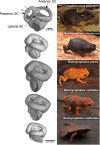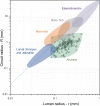Semicircular canal size constrains vestibular function in miniaturized frogs
- PMID: 35704574
- PMCID: PMC9200278
- DOI: 10.1126/sciadv.abn1104
Semicircular canal size constrains vestibular function in miniaturized frogs
Abstract
Miniaturization has evolved repeatedly in frogs in the moist leaf litter environments of rainforests worldwide. Miniaturized frogs are among the world's smallest vertebrates and exhibit an array of enigmatic features. One area where miniaturization has predictable consequences is the vestibular system, which acts as a gyroscope, providing sensory information about movement and orientation. We investigated the vestibular system of pumpkin toadlets, Brachycephalus (Anura: Brachycephalidae), a clade of miniaturized frogs from Brazil. The semicircular canals of miniaturized frogs are the smallest recorded for adult vertebrates, resulting in low sensitivity to angular acceleration due to insufficient displacement of endolymph. This translates into a lack of postural control during jumping in Brachycephalus and represents a physical constraint resulting from Poiseuille's law, which governs movement of fluids within tubes.
Figures




References
-
- Muller M., Size limitations in semicircular duct systems. J. Theor. Biol. 198, 405–437 (1999). - PubMed
-
- Beck J. C., Gilland E., Tank D. W., Baker R., Quantifying the ontogeny of optokinetic and vestibuloocular behaviors in zebrafish, medaka, and goldfish. J. Neurophysiol. 92, 3546–3561 (2004). - PubMed
LinkOut - more resources
Full Text Sources

